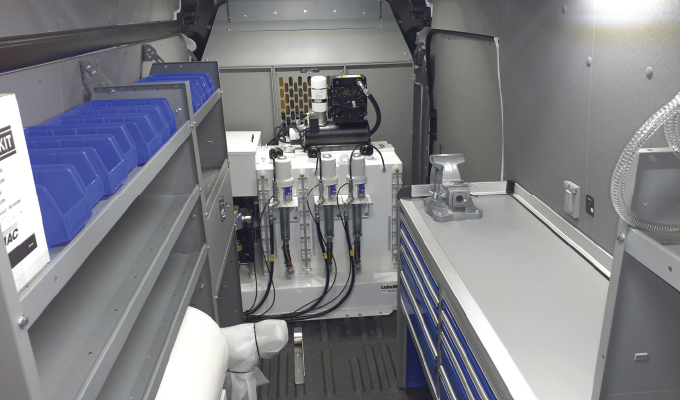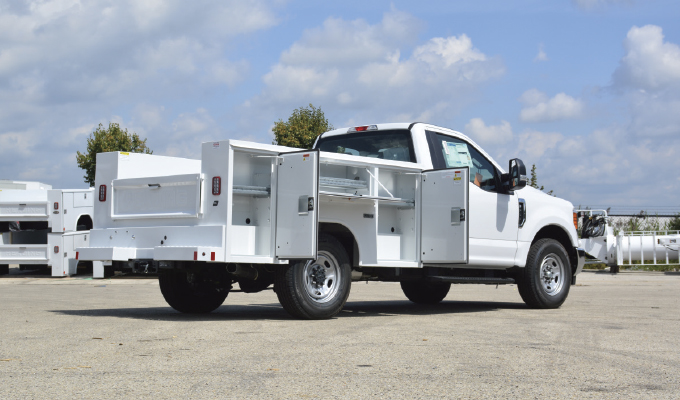For vocational fleet operators, your commercial trucks, vans, and equipment are tools vital to servicing your customers. To maximize the potential of these assets, you need a strong upfitting strategy that transforms these vehicles into vocational powerhouses that generate revenue for your business. However, after three-plus years of unprecedented disruptions throughout the entire automotive supply chain, many upfit best practices have fallen by the wayside as fleet operators find themselves scrambling to adjust.
As the supply chain continues to rebound, now’s a terrific time to re-assess your upfit strategy to make sure you’re well positioned to adapt to an evolving business environment while still adhering to tried and true best practices. To help you craft a comprehensive upfit strategy that aligns with the needs of your business, here are a few key factors to consider.
ENGAGE FLEET STAKEHOLDERS
The importance of understanding the intended job function of each unit and how it supports your business cannot be overstated. The more you know about how your business functions on a daily basis, the better equipped you’ll be to develop specifications that help your business enhance productivity and generate revenue. The best advice I can offer is to remember that developing vehicle and upfit specs isn’t just a fleet project; it’s an overall business project.
You’ll benefit greatly by soliciting input from other fleet stakeholders throughout your business, particularly your operations and frontline employees. Collaboration is key. Spend a day with your technicians in the field. Interview operations managers to find out how vehicles are used and if there are opportunities for improvement. Try to be as hands on as possible and involve your various stakeholders in the process to avoid a potential disconnect between what looks good on paper and how the units are being used in the field.
From there, you’re ready to engage your fleet management company, your upfit partner, and their engineering teams to ensure your upfit strategy aligns with the actual daily use of your vehicles. Together, you’re able to have productive conversations around the products, tools, and equipment your drivers are transporting and, in turn, develop an upfit solution that maximizes the functionality of each vehicle.
THOROUGH YET MANAGEABLE
While it is critical that you prioritize upfitting each vehicle for its intended function, you also want to maintain a reasonable number of specs for your fleet. Ideally, you don’t want an overwhelming library of upfit specs to manage and further complicate your acquisition process.
This standardization also often makes the vehicles more cost effective by eliminating unnecessary upfitting and allowing your upfit partners to source the necessary components in greater volume. Additionally, if you’re able to limit the number of upfit solutions in your catalog, you’ll have greater flexibility to shuffle units across your fleet to areas or roles where the vehicle is needed most. This streamlining also benefits you when it comes time to sell the unit. With an upfit package that’s useful across numerous applications, the unit will appeal to more potential buyers, maximizing resale value and reducing your total cost of ownership.

BE PROACTIVE IN PLANNING
One point that cannot be stressed enough is to have a proactive strategy in place for developing vehicle and upfit specifications. Take your time and be thoughtful in your execution. Proper planning helps to ensure a quality upfit package which helps to maximize productivity in the field.
The first thing you need to determine is when new vehicles need to arrive in the field. Be sure to allow time to thoroughly review specifications and be mindful of factory order cycles as well as the production schedule of your upfit partner. You’ll also want to keep in mind that while production timelines continue to improve, you still need to expect—and plan accordingly—for extended lead times.
While placing factory orders is still the preferred option, given lingering supply chain disruptions, you need to be well prepared to adjust accordingly. Today, many fleet operators are leveraging alternative methods to procure vehicles (stock purchases, pools, etc.) to overcome gaps in factory ordering. This flexibility certainly extends to your upfit strategy as well. You’ll want to be sure to have contingency plans in place and align with an upfit partner who is able to easily adapt to unforeseen detours.
A good rule of thumb is to anticipate a minimum of six to nine months to receive your vehicle; potentially longer if your units require extensive or complex upfitting. This is where seamless collaboration and simplified communication across your entire supply chain becomes important. You, your fleet management provider, and your upfit partner need to be aligned on OEM production schedules, upfitter production capacity, delivery scenarios, target in-service dates, etc.
BUDGET ACCORDINGLY
Unfortunately, economic headwinds continue to impact the cost of new vehicles. This sentiment holds true for the upfit sector as well amidst an uptick in commodity (aluminum, steel, etc.) and component pricing. The good news is that while vehicle prices are still above historic norms, you’re likely to see a decrease in vehicle prices for the 2024 model year—approximately 2.5%—easing the budget crunch slightly.
With that in mind, you’ll want to be proactive in your planning and budget allocation to ensure you’re well positioned to order vehicles. Rather than simply planning for the year ahead, most fleet operators will benefit from a more macro approach. If you’re able to forecast three to five years out, you’ll have greater financial flexibility to adjust to unforeseen challenges or have capital available to take advantage of cost-savings opportunities that may arise.
ALIGN WITH STRONG PARTNERS
Generally speaking, a multi-year relationship with a fleet management provider and upfit partner is extremely beneficial for most fleet operators. Ideally, you should be looking for a collaborative partnership that brings continuity to the entire process.
Working closely with your fleet management and upfit partners and maintaining an open dialogue helps to ensure everyone is aligned on your fleet and overall business strategy. Additionally, these strategic partnerships provide greater visibility into precisely how a particular vehicle is being used in the field, allowing you to collaborate and pivot accordingly if there’s a spec or other OEM change that may impact your upfit buildout. If you find yourself in a cycle of constant change, always looking for the fastest or cheapest option, you’ll likely experience a greater number of disruptions that will certainly impact your fleet stakeholders.
Also be sure to keep in mind, when it comes to selecting an upfit partner, you’ll benefit greatly by doing your homework ahead of time.
Consult your fleet management provider. Network with your peers from across the industry to understand why they partner with a particular upfitter. Visit upfitters in person to get a better sense of their facilities and their culture. You’ll want to ensure the upfitter’s capabilities align with the needs of your organization. If you have a complex fleet, does your upfitter have the core competencies and engineering expertise to properly produce those units? If you have a decentralized fleet with a national footprint, an upfit partner with the ability to accommodate multiple delivery options (ship-thru, drop-ship, regional builds, etc.) can help minimize delivery and licensing costs.
Most importantly, remember, there isn’t a one-size-fits-all solution when it comes to developing an effective upfit strategy. While the factors above are certainly important to consider, you’ll want to develop an upfit strategy based on what’s most critical to the success of your business.

ABOUT THE AUTHOR
Ted Davis is senior vice president and chief operating officer, Manufacturing & Distribution, with Holman. To learn more about how Holman’s holistic fleet management strategies and customized upfit solutions can help maximize the potential of your fleet as a strategic business asset, visit holman.com.




